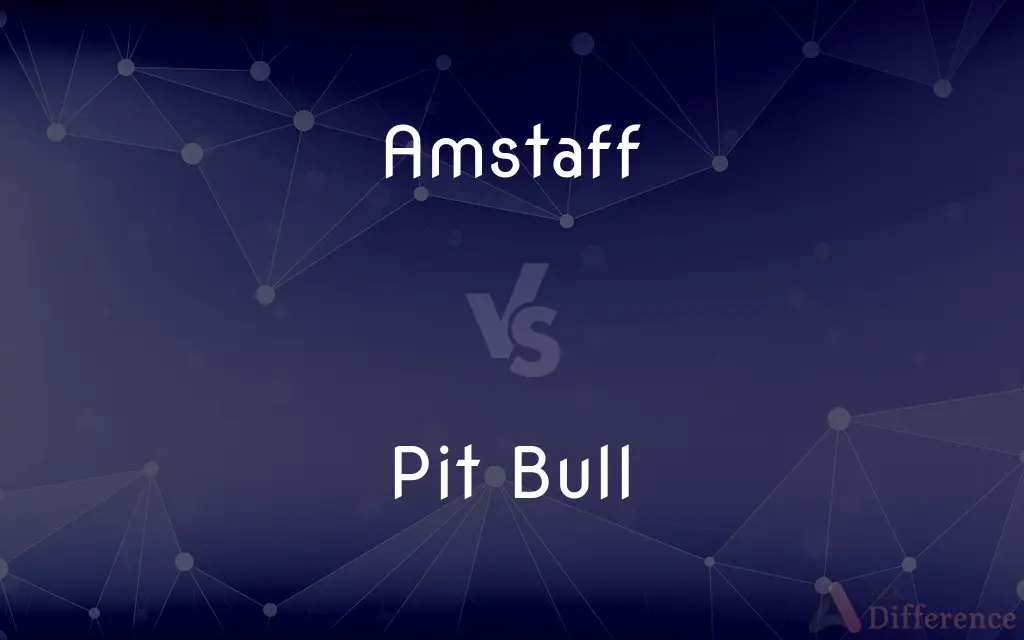Amstaff vs. Pit Bull — What's the Difference?
By Tayyaba Rehman & Urooj Arif — Published on August 3, 2024
Amstaffs are muscular, AKC-recognized, while Pit Bulls, not AKC-recognized but UKC-recognized, have diverse sizes/lineages. Both share origins and traits.

Difference Between Amstaff and Pit Bull
Table of Contents
ADVERTISEMENT
Key Differences
The American Staffordshire Terrier (Amstaff) and the American Pit Bull Terrier (Pit Bull) share a common ancestry, with both breeds descending from bulldogs and terriers. However, over time, breeders have differentiated them through selective breeding for specific traits.
The Amstaff, recognized by the American Kennel Club (AKC), has been bred to conform to specific standards that emphasize a muscular build, courageous temperament, and loyalty. The breed is known for its strength, intelligence, and affectionate nature towards families.
The American Pit Bull Terrier, recognized by the United Kennel Club (UKC), is admired for its strength, confidence, and zest for life. Pit Bulls are characterized by their athletic build, intelligence, and strong desire to please their owners. They possess a wide range of sizes and colors, reflecting the diversity within the breed. Pit Bulls are often subject to breed-specific legislation due to misconceptions about their temperament.
Both breeds require responsible ownership, socialization, and training to bring out their best qualities. They can make excellent companions for active individuals or families due to their loyalty, affection, and protective nature. However, the Amstaff typically has a more uniform appearance due to AKC breed standards, while the Pit Bull's appearance can vary more widely.
In the public eye, both breeds often face challenges due to their historical association with dog fighting. It's important for prospective owners to understand each breed's needs and characteristics and to commit to providing a loving, structured environment. Despite their tough exterior, both the Amstaff and Pit Bull are capable of great gentleness and are eager to form strong bonds with their human counterparts.
ADVERTISEMENT
Comparison Chart
AKC Recognition
Yes
No
UKC Recognition
No
Yes
Size
Slightly smaller and stockier
More variation in size
Temperament
Loyal, confident, good-natured
Energetic, eager to please, strong-willed
Purpose
Show dog, companion
Companion, work, and sport
Appearance
Uniform, due to breed standards
Diverse, reflecting varied lineage
Breed-Specific Legislation Impact
Often included
Frequently targeted
Ideal Owner
Active individuals or families, committed to training and socialization
Same as Amstaff, with emphasis on understanding breed characteristics
Compare with Definitions
Amstaff
Subject to breed-specific legislation.
Owners may need to navigate local laws when moving with an Amstaff.
Pit Bull
Benefits from positive reinforcement training.
Pit Bulls respond well to rewards-based training methods.
Amstaff
Recognized by the AKC for its strength and loyalty.
Many Amstaffs excel in obedience and agility competitions.
Pit Bull
Known for its athleticism and zest for life.
Pit Bulls enjoy activities like running and agility training.
Amstaff
Known for its affectionate nature towards families.
Amstaffs often form strong bonds with all family members.
Pit Bull
Displays a wide range of sizes and colors.
Pit Bulls can range from sleek and athletic to robust and stocky.
Amstaff
Requires early socialization.
Puppy classes are beneficial for Amstaffs to become well-adjusted adults.
Pit Bull
Not recognized by the AKC but cherished by many.
Pit Bull rescue organizations advocate for the breed's positive traits.
Amstaff
A muscular and confident companion.
The Amstaff enjoys long walks and interactive playtime with its family.
Pit Bull
Faces misconceptions about its temperament.
Despite stereotypes, Pit Bulls can be gentle and loving pets.
Common Curiosities
Why are Pit Bulls often misunderstood?
Pit Bulls are misunderstood due to their historical association with dog fighting, leading to misconceptions about their aggression, despite many being loving and gentle pets.
Are Amstaffs and Pit Bulls suitable for apartments?
Both can adapt to apartment living if they receive adequate exercise, mental stimulation, and attention, but their energy levels and need for space should be considered.
What kind of exercise do Amstaffs and Pit Bulls need?
They require regular, vigorous exercise to maintain their physical and mental health, including walks, playtime, and opportunities for running.
What are the challenges of owning an Amstaff or Pit Bull?
Owners may face breed-specific legislation, insurance restrictions, and the need for committed training and socialization to ensure their dog is a well-adjusted member of the community.
What should I feed my Amstaff or Pit Bull?
A balanced diet suited to their age, size, and activity level is important, with high-quality commercial or home-prepared food (under veterinary guidance).
Can Amstaffs and Pit Bulls participate in dog sports?
Yes, they excel in dog sports such as agility, obedience, and weight pulling, benefiting from the physical and mental challenges these activities provide.
What is the main difference between an Amstaff and a Pit Bull?
The main difference lies in their breed recognition and standards, with Amstaffs recognized by the AKC and having more uniform breed standards, while Pit Bulls are recognized by the UKC and display more variation in appearance.
How can I decide which breed is right for me?
Consider your lifestyle, ability to provide sufficient exercise, training, and socialization, and willingness to navigate potential legal and social challenges associated with the breed.
Can Amstaffs and Pit Bulls be good family pets?
Yes, both breeds can make excellent family pets when properly trained and socialized, known for their loyalty and affection towards their families.
How do Amstaffs and Pit Bulls get along with other pets?
With proper socialization from a young age, both breeds can get along with other pets, but individual temperaments and past experiences can affect their compatibility.
How do I socialize an Amstaff or Pit Bull?
Early, positive exposure to different people, animals, environments, and experiences is crucial for socialization, along with consistent training and reinforcement.
What is the best way to train an Amstaff or Pit Bull?
Positive reinforcement training methods, including rewards and praise, are effective, focusing on consistency, patience, and understanding their needs and motivations.
What are the grooming needs of Amstaffs and Pit Bulls?
Both have short coats that require minimal grooming, including regular brushing to minimize shedding and occasional baths to keep their coat clean.
How long do Amstaffs and Pit Bulls typically live?
Both breeds have a life expectancy of around 12-16 years, with proper care, nutrition, and regular veterinary check-ups.
Are Amstaffs and Pit Bulls prone to any specific health issues?
Both breeds can be prone to certain genetic health issues, including hip dysplasia and heart conditions, so regular veterinary check-ups are important.
Share Your Discovery

Previous Comparison
CPU vs. GPU
Next Comparison
Near Field vs. Far FieldAuthor Spotlight
Written by
Tayyaba RehmanTayyaba Rehman is a distinguished writer, currently serving as a primary contributor to askdifference.com. As a researcher in semantics and etymology, Tayyaba's passion for the complexity of languages and their distinctions has found a perfect home on the platform. Tayyaba delves into the intricacies of language, distinguishing between commonly confused words and phrases, thereby providing clarity for readers worldwide.
Co-written by
Urooj ArifUrooj is a skilled content writer at Ask Difference, known for her exceptional ability to simplify complex topics into engaging and informative content. With a passion for research and a flair for clear, concise writing, she consistently delivers articles that resonate with our diverse audience.













































